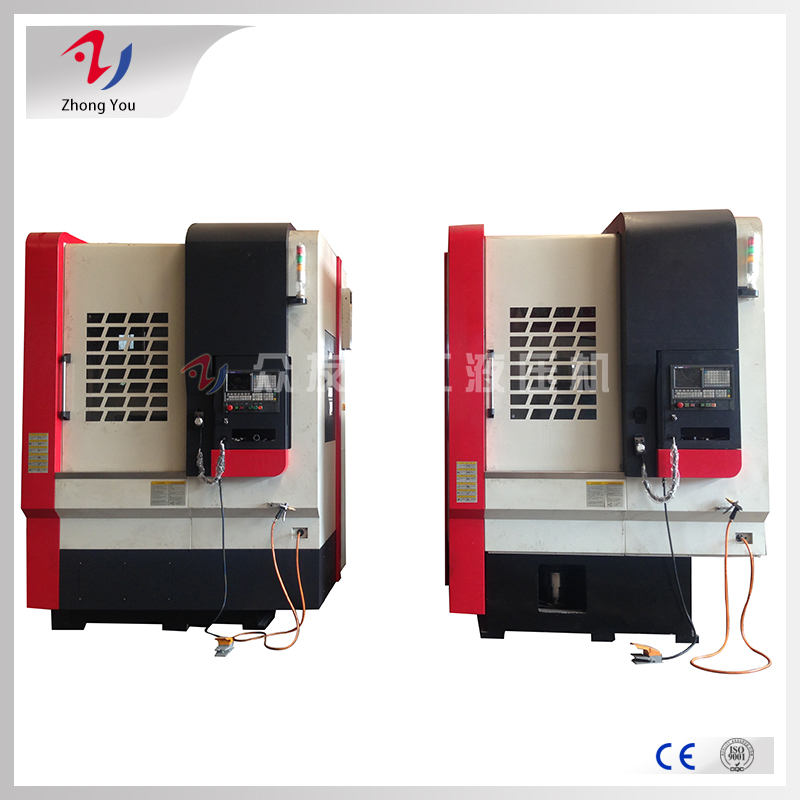Errors include machining errors, installation errors and positioning errors. Among them, the latter two errors are related to the positioning and installation of the workpiece and the tool, and have nothing to do with the processing itself. In order to improve the machining accuracy and reduce the machining error, we must first select a high-precision machine tool to ensure the installation and positioning accuracy of the workpiece and the tool, and then mainly related to the CNC lathe processing technology.
The components of the process system, including CNC lathes, tools, fixture manufacturing errors, installation errors, the use of wear and tear directly affect the machining accuracy of the workpiece. That is to say, in the process of processing system will produce a variety of errors, thus changing the tool and workpiece in the process of cutting motion in the relationship between the position and affect the machining accuracy of parts. CNC lathe processing of titanium Hao machinery, professional quality assurance, these errors and the process system itself structure state and cutting process, the main factors resulting in processing errors are:
1. Error of machining principle
Machining principle error is due to the use of approximate machining motion or approximate tool contour error, because there is an error in the machining principle, it is called the machining principle error. As long as the principle error is within the allowable range, this processing method is still feasible.
2. Geometric error of CNC lathe
The manufacturing error, installation error and wear in use of the machine tool directly affect the machining accuracy of the workpiece. Which is mainly the machine tool spindle rotary motion, machine tool guide linear motion and machine tool transmission chain error.
3. Manufacturing error and elastic deformation of cutting tools
Many of us have such experience, that is, after turning a few millimeters of cutting depth in the previous knife, when we found that we were still a few wires or more than a dozen wires short of the desired size, when we carried out the next one-size-fits-all cutting as planned, we found that we had cut a lot more and the size might be too poor. Some people say that this may be because the machine gap is relatively large, and in the same feed direction is not affected by the gap, the real reason is the elastic deformation and elastic recovery.
Elastic deformation is manifested in the deformation of objects such as tools, machine tool screw pairs, tool holders, and machined parts themselves, which causes the tool to retreat relative to the workpiece. When the resistance is reduced, the deformation recovers and over-cutting occurs, causing the workpiece to be scrapped. The ultimate cause of deformation is the lack of strength of these objects and the cutting force is too large.
Elastic deformation will directly affect the dimensional accuracy of parts processing, and sometimes it will also affect the geometric accuracy (for example, taper is easy to occur when the parts are deformed, because the deformation amplitude far away from the chuck is greater). We can try to improve the strength of the tool. Sometimes we cannot choose or change the strength of the machine tool and the parts themselves, so we can only try to overcome the elastic deformation by reducing the cutting force, the smaller the depth of cut, the sharper the tool, the lower the hardness of the workpiece material, and the reduction of the cutting speed will reduce the actual cutting resistance and reduce the elastic deformation.
Therefore, in order to ensure the dimensional accuracy of the workpiece, we often separate finishing, semi-finishing and rough machining, that is to say, separate the different processes with large elastic deformation and small elastic deformation (the pursuit of efficiency is basically not the pursuit of precision during rough machining, the tool needs to be blunt, focus on strength, small cutting amount during finishing, pursue precision, focus on sharpness and reduce cutting resistance), trial cutting is carried out according to the cutting depth during actual processing in different processes to ensure that the resistance and elastic deformation amplitude during trial cutting are roughly the same as those during actual processing, to ensure that the coordinate system of numerical control machine tools is established accurately, and to ensure that the feed of ordinary machine tools is accurate. Then, as far as possible, use relatively sharp tools during finishing to reduce cutting resistance and deformation.
The manufacturing error, installation error and wear of the tool in use all affect the machining accuracy of the workpiece. In the cutting process, the cutting edge, the cutter face and the workpiece, the chip produce strong friction, so that the tool wear. When the tool wear reaches a certain value, the surface roughness value of the workpiece increases, and the color and shape of the chip change, accompanied by vibration. Tool wear will directly affect cutting productivity, machining quality and cost.
4. Influence of cutting elements on surface roughness
When the workpiece material is hard, the surface roughness of the workpiece is better after processing. In addition, when the plasticity and ductility of the workpiece material are higher (such as copper and aluminum), the sharper the tool of the CNC lathe is needed to process a better surface roughness. Compared with steel processing, gray cast iron processing requires a higher hardness of the tool because of its complex composition and high degree of impurities. Some ductility higher strength and higher alloy materials, you need sharp but can guarantee the strength of the tool, so it is more difficult to process (such as stainless steel, nickel-based heat-resistant alloy, titanium alloy, etc.).
In addition to the requirements of the material on the tool, the cutting elements of the CNC lathe will also have an impact on the surface roughness. When the finishing cutting depth is too small, even smaller than the thickness of the tool edge, the blade can no longer achieve normal cutting, so extrusion will result in poor surface roughness. When the cutting depth is too large, even the tool is bent, then the workpiece material is torn down, so in the workpiece will leave a lot of filiform iron residue and more obvious lines. The effect of feed speed on the surface roughness of the workpiece is also quite obvious. When the feed speed is accelerated or the tool sub-angle is not appropriate, the feed grain height will be increased, and the surface roughness will become worse.
When the cutting tool of CNC lathe is not very sharp, the cutting depth is too small, even smaller than the thickness of the blade, which is no longer normal cutting. It can only belong to "scraping" or "grinding". The surface roughness of the processed workpiece will decrease, and the surface of the workpiece will appear fine white silk, which seems to be covered with a layer of white fog, so attention should be paid to control.
5. Fixture error
CNC lathe fixture error includes positioning error, clamping error, fixture installation error and tool error, these errors are mainly related to the fixture manufacturing and assembly accuracy.
6. The influence of speed on processing
Under normal circumstances, everyone knows that the higher the speed, the higher the efficiency of CNC lathe cutting, and the efficiency is profit. Therefore, we must run the highest possible speed for cutting when conditions permit. But the speed, the diameter of the workpiece to determine the cutting line speed, line speed by the workpiece hardness, strength, plasticity, carbon content, containing the amount of difficult cutting alloy and the hardness of the tool and geometric properties and other factors, so to select the highest possible speed under the line speed limit. In addition, the speed of high and low selection according to different materials of the tool to determine, such as high-speed steel processing steel, the lower the speed of the roughness is better, while the carbide tool is higher speed, the roughness is better. Furthermore, in the processing of slender shaft or thin-walled parts, we should pay attention to the speed adjustment to avoid the resonance area of the parts, to prevent the generation of vibration patterns affect the surface roughness.











